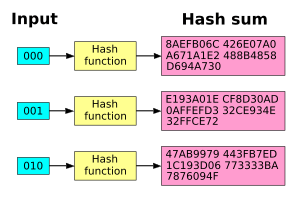Avalanche effect facts for kids
The avalanche effect is a cool idea used in cryptography, which is about keeping information secret and safe. Think of it like a tiny change causing a huge difference!

This effect is super important for special computer programs called block ciphers and cryptographic hash functions. These programs are like secret codes. The avalanche effect means that if you change just a tiny bit of the information you put in (the "input"), the information that comes out (the "output") should change a lot.
For example, in a good secret code, if you change just one letter in a message or one tiny part of the secret key, the coded message should look totally different. This makes it very hard for anyone to guess or crack the secret code.
This idea helps small changes spread quickly through the computer program. It makes sure that every single part of the output depends on every single part of the input. This makes the code much stronger and safer.
The idea of the avalanche effect was first talked about by a person named Horst Feistel in 1973. Later, it was also connected to another important idea called "Shannon's property of confusion".
If a secret code or a hash function doesn't have a strong avalanche effect, it means it's not very random. This is bad because a code-breaker might be able to guess parts of the original secret message just by looking at the coded message. This could help them break the code completely!
That's why when people create strong secret codes or hash functions, they always try to build in a good avalanche effect. It's one of the main goals! It's a bit like the butterfly effect in math, where a small change can lead to big, unpredictable results.
Contents
Why is it called the Avalanche Effect?
The name "avalanche effect" comes from real avalanches in the mountains. Imagine a tiny rock falling down a snowy mountain. That small rock can start a huge, destructive avalanche of snow and ice.
It's the same idea with secret codes. A very small change in the input (like the tiny rock) should cause a massive change in the output (like the huge avalanche changing the whole landscape).
What is the Strict Avalanche Criterion (SAC)?
The Strict Avalanche Criterion (SAC) is a special rule for how good the avalanche effect is. It's really important in cryptography.
This rule says that if you change just one tiny bit of information in the input, then every single bit in the output should change with a 50% chance. This means it's like flipping a coin for each output bit – it should be equally likely to change or stay the same.
The SAC was first introduced by Webster and Tavares in 1985. Today, it's a must-have for all modern secret coding systems. For example, all the finalists in the competition to create the AES (a very strong secret code) met this important rule.
What is the Bit Independence Criterion (BIC)?
The Bit Independence Criterion (BIC) is another important rule. It says that when you change just one input bit, any two output bits should change independently of each other.
This means that if one output bit changes, it shouldn't force another output bit to change too. They should change on their own, without depending on each other. If they always changed together, it would make the code weaker and easier to guess.
See also
- A. F. Webster and Stafford E. Tavares, "On the design of S-boxes", Advances in Cryptology - Crypto '85 (Lecture Notes in Computer Science), vol. 219, pp. 523–534, 1985.
- Horst Feistel, "Cryptography and Computer Privacy." Scientific American, Vol. 228, No. 5, 1973. (JPEG format scanned)
See also
 In Spanish: Efecto avalancha para niños
In Spanish: Efecto avalancha para niños

